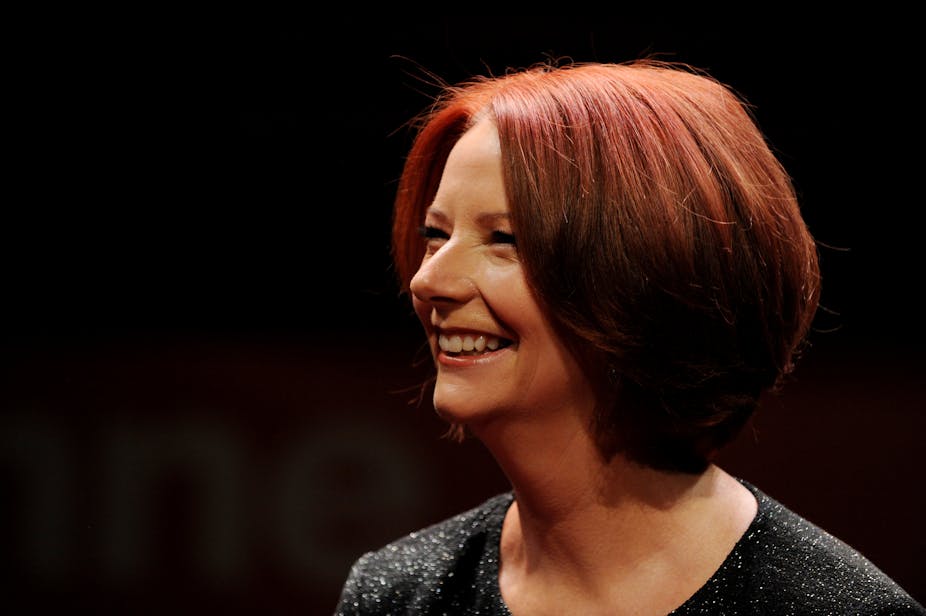Former prime minister Julia Gillard has returned to the spotlight after maintaining a dignified silence since her removal as Labor leader in June. Since the defeat of the federal Labor government, she has been rapturously received at public functions in Melbourne and Sydney, signalling that she is likely to enjoy a high public profile in the years to come.
Political parties are often keen to encourage former leaders to move on to enable a clear run for the party’s new leader. But the tendency of political careers to commence early in life has meant that prime ministers face political defeat in middle age, with decades left to participate in public life.
The most important determinant of a former prime minister’s public profile is the viability of the political project that they represented. Some very successful leaders such as Bob Hawke or Robert Menzies seemed out of step soon after their terms ended, but other less successful leaders were better attuned to the spirit of the age.
Gillard will enjoy a long political afterlife because of her political project. The combination of a cautious social democracy and an appeal to feminism has a significant social base. The struggles she experienced as prime minister resonate with the experience of many women, even those who are strongly critical of aspects of her record in government. Her market-friendly social democracy is the common sense of much of the global political class.
Paul Keating’s long political afterlife reflects the popularity of his economic and social liberalism among a significant minority of Australian voters. Malcolm Fraser for a time seemed forgotten, but his reinvention as the representative of an older tradition of patrician liberal-conservatism struck a chord with many voters disenchanted with the new Australia that emerged in the 1990s.
In the immediate aftermath of the 2007 federal election, some suggested John Howard would be forgotten, but Tony Abbott’s ascension revealed the continuing appeal of Howard’s brand of populist conservatism to voters. Billy Hughes lost the prime ministership in 1922 but remained in parliament for another 30 years. The “Little Digger”, as he was known, espoused a militarist and economically interventionist form of Australian nationalism that appealed powerfully to many voters.
Gillard is concerned with the vindication of her legacy, but this desire alone is not enough to ensure a successful post-politics career. Hawke’s self-belief and desire for vindication made Kevin Rudd seem modest. Despite this, Hawke struggled for relevance after his prime ministership.
As Hawke’s speechwriter Stephen Mills observed, his problem was that his record as an industrial conciliator became largely irrelevant in the 1990s as trade union membership collapsed and the balance of power shifted towards employers. Hawke had only one great moment in the public spotlight after leaving office: in 1995, he appeared before the Industrial Relations Commission as a union advocate in their battle with mining company CRA.
Menzies, like Rudd, fought his way back from the humiliation of rejection by his own party in 1941 to return to the prime ministership in 1949. Yet after he retired in 1966, Menzies soon seemed yesterday’s man in the age of John Gorton and Gough Whitlam. Once ebullient and indefatigable, Menzies became an isolated old man whose favoured correspondent was B. A. Santamaria, most notable for his role as the DLP’s standard-bearer.

The political afterlife of former prime ministers is also dependent on the changing extent to which Australian politics has been integrated into transnational networks.
For colonials of talent and breeding, the British Empire once offered a world beyond the dusty country town of Canberra. Stanley Bruce lost the prime ministership at age 46 in 1929 and found his hopes for a return blocked by Joe Lyons. A diplomatic posting took Bruce to London, then came a smooth integration into the British ruling class, a senior position with the United Nations and eventually a peerage.
In 1941, Menzies may have dreamt of an entry to British politics. His rival, Richard Casey, spent the war as a British diplomat and Indian governor and in 1960 was appointed a life peer of the British House of Lords.
Australia’s integration in global networks ebbed with the decline of the British Empire but has been powerfully revived in the current era of globalisation. Today, the European Union provides many European politicians with a career after national politics. Likewise, the transnational community of think tanks and corporate philanthropy has offered an opportunity to Gillard, who has become a fellow with the American Brookings Institute. It is likely that Rudd will eventually follow a similar road.
In the years of the post-war long boom and the difficult decades of restructuring that followed, the Australian prime ministership stood as the summit of a politician’s career. It seems this may no longer be the case.

